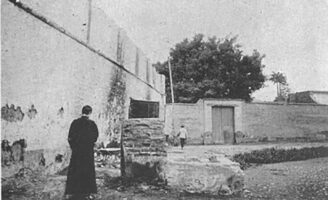Republics of Difference ‑Graubart
By Karen Graubart | Published on November 26, 2021
In 1475 two Jewish men, rabbi Mosé Maturel and his son-in-law Muysé, and a Christian friend, Alfonso de Córdoba, walked into the office of one of Seville’s many Christian notaries. The two Jewish men, in the notary’s formula, “renounced the law of Moses,” indicating that they were placing themselves temporarily under the jurisdiction of Christian judges for the purposes of this visit. Along with other unnamed Jews, they had abandoned their synagogue and were praying together in another house. The document they asked the notary to draw up obligated them to return to the synagogue and not to pray or hold cabildo [council] meetings elsewhere with any other Jews, under a substantial cash penalty. Whoever violated the agreement would pay the sum to the third party, Alfonso de Córdoba, a member of the household of a powerful Castilian nobleman. The Rabbi and his son-in-law gave authority to “whatever judges of this city” to exact the penalty[1].
This odd document, wherein men who embraced Jewish law as upheld by their local Jewish judges subordinated themselves to a Christian notary and to unnamed Christian judges for the sake of accountability to their religious community, reveals one way that legal pluralism informed group formation in the early modern Spanish kingdoms. Muslims and Jews in the Christian kingdom of Castile could live under their own authorities and judges, at least til the late 15th century. They also had access to local and royal Christian authorities, which, as here, enabled them to venue-shop for certain outcomes. In this case, Jewish citizens gained an outsider’s enforcement of their oath not to splinter their own religious community. It is likely that the rabbi also made a pledge within his own faith and law not to exit with a minyan (ten Jewish men) or form a new congregation, with a spiritual rather than a financial penalty. For the sake of enforcement he turned outside the Jewish community: Christian courts might well be more effective in collecting his penalty, and the shame of paying a Christian for failure to carry out a Jewish obligation would confer additional spiritual punishment. It might also encourage Christians to associate Jewish religious practices with their wealth, perhaps not an intended effect and an unfortunate one[2]. But the men invited a Christian to enforce a Jewish obligation, renouncing Jewish judges’ authority in the matter, in the public space of the Christian notary’s office.
My larger project concerns the ways that coexisting and co-recognized forms of law and legal institutions, often called legal pluralism, shaped everyday life in the early modern Spanish and Spanish American world[3]. The existence of multiple legal jurisdictions did not imply an equality or equivalence: indeed, the conquered or subordinate groups generally had to signal their humiliated status by paying a sum of collective tribute[4]. Many scholars have examined the interrelations of these jurisdictions as forms of negotiation, wherein less powerful groups sought to bring their interests to a political table, or to assert control over particular aspects of their lives. Here I want to think a little differently, about the ways that self-governance contributed to the ways that communities understood themselves and others in a complex legal environment.
Jurisdiction mattered to minority communities, but it also offered cues for the more powerful to imagine them, often consequentially. Spaniards and Christians often understood Jews, Muslims, sub-Saharan Africans and Indigenous peoples through their collective or corporate presence, which could shore up beliefs about their difference, including the makeup of their bodies, minds, and emotions. These could and did feed into popular discourses and policy positions. In the book from which this talk is excerpted, I look at the ways that the occupation of space and the use of law produced both internal organization and external perceptions of these groups across the Atlantic, using fifteenth century Seville and sixteenth-seventeenth century Lima as my case studies.
The corporate entities with common interests that issued law within this hierarchy were usually called “repúblicas.” Republics existed throughout the empire, from artisan guilds enforcing labor and craft standards on members to municipal concejos or cabildos, which managed city governance and tax collection. The crown created or empowered these jurisdictions as ways to build hegemony while delegating undesireable tasks. Republics used law[5] to manage their internal concerns insofar as it did not draw the attention of royal or ecclesiastic powers. The crown and the church, of course, always reserved the right to step in and assert control. But it was in their interest not to do so, and the crown in particular played republics against one another, to shore up its own authority.
The republic model was exported to the Americas with the Spanish conquistadores, who were empowered to form cabildos of citizen-settlers on urban frontiers. The crown promoted these cabildos but, to keep them from accruing too much power, affirmed competing jurisdictions among them, leaving all dependent on the monarch for inevitable conflict resolution.
In the Americas, the main vehicle for constraining the citizen-conquistadors was indigenous sovereignty. Spain claimed to have conquered American territories away from their tyrannical kings and emperors, and entered into a voluntary relationship of vassalage with their natural lords, whom the crown identified as the local or regional hereditary leaders of indigenous polities. In the Andes, this meant that local rule, theoretically, was left intact via Andean kurakas, also called caciques. Kurakas, supplemented by other Indigenous authorities, governed their subjects, who were also subjects of the king and converts to Christianity.
As you can imagine, this jurisdiction had real constraints: the king always reserved capital punishment to himself and placed most criminal jurisdiction in the hands of his Spanish representatives, rarely allowing subordinate judges to exact corporal penalties. He also served as appeals court of last resort for any jurisdiction. But because local jurisdictions could overlap or be contentious or ambiguous, Indigenous and Spanish authorities came into regular conflict over resource use, human labor, and what we might think of as questions of internal coherence such as succession rules for leaders and judges. Colonial Indigenous law was also shaped by colonial interactions: far from having continuity with pre-conquest practices, it was often modified in the process of generalization by Spanish jurists or in its narration by Indigenous litigants for Spanish ears[6]. Yet that law mattered, and governed the lives of many Indigenous subjects. And, as I will argue, the way that law defined colonized subjects — as it was used by both Indigenous and Spanish litigants — in particular ways, especially racializing ways, had unexpected repercussions. These repercussions were both discursive and material. In my presentation, I will discuss the case of Lima and its Cercado, a walled neighborhood placed on the edge of the capital city in the late sixteenth century (see attached map), to illustrate how even tenuous and deeply embedded self-governance could produce an afterlife that affected and differentiated colonial subjects.
Notes
- Archivo de Protocolos de Sevilla.[↑]
- Francesca Trivellato on the ways that Jewishness was associated with venality comes to mind.[↑]
- On this concept, see Benton, Law and Colonial Cultures; Benton and Ross, Legal Pluralism and Empires; Owensby, Empire of Law.[↑]
- Spanish scholars have periodically debated the language used to characterize the interactions of the three religions in the medieval period. Convivencia, a term coined by Américo Castro for this purpose in 1948, has been criticized for underplaying the violence of that “living together,” though it still carries weight as a counter to the untenable idea that Spain’s roots are European and Christian. For the historiography and an argument that the term still lacks nuance for understanding the power dynamics of medieval Iberia, which were perhaps less unique in Europe than the debate has implied, see Maya Soifer Irish, “Beyond Convivencia.”[↑]
- This law is occasionally referred to as costumbre or custom, but there was no clear distinction between “real law” and “customary law,” the main divisions would have been between law and natural law, as well as royal law and other law. See Herzog, “Colonial Law and Native Customs” for a discussion.[↑]
- See Herzog “Colonial Law and Native Customs” for some examples, as well as Graubart, With Our Labor and Sweat, Ch 5.[↑]



